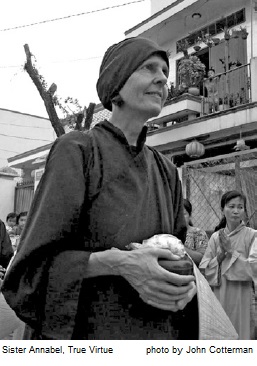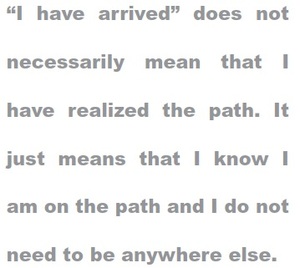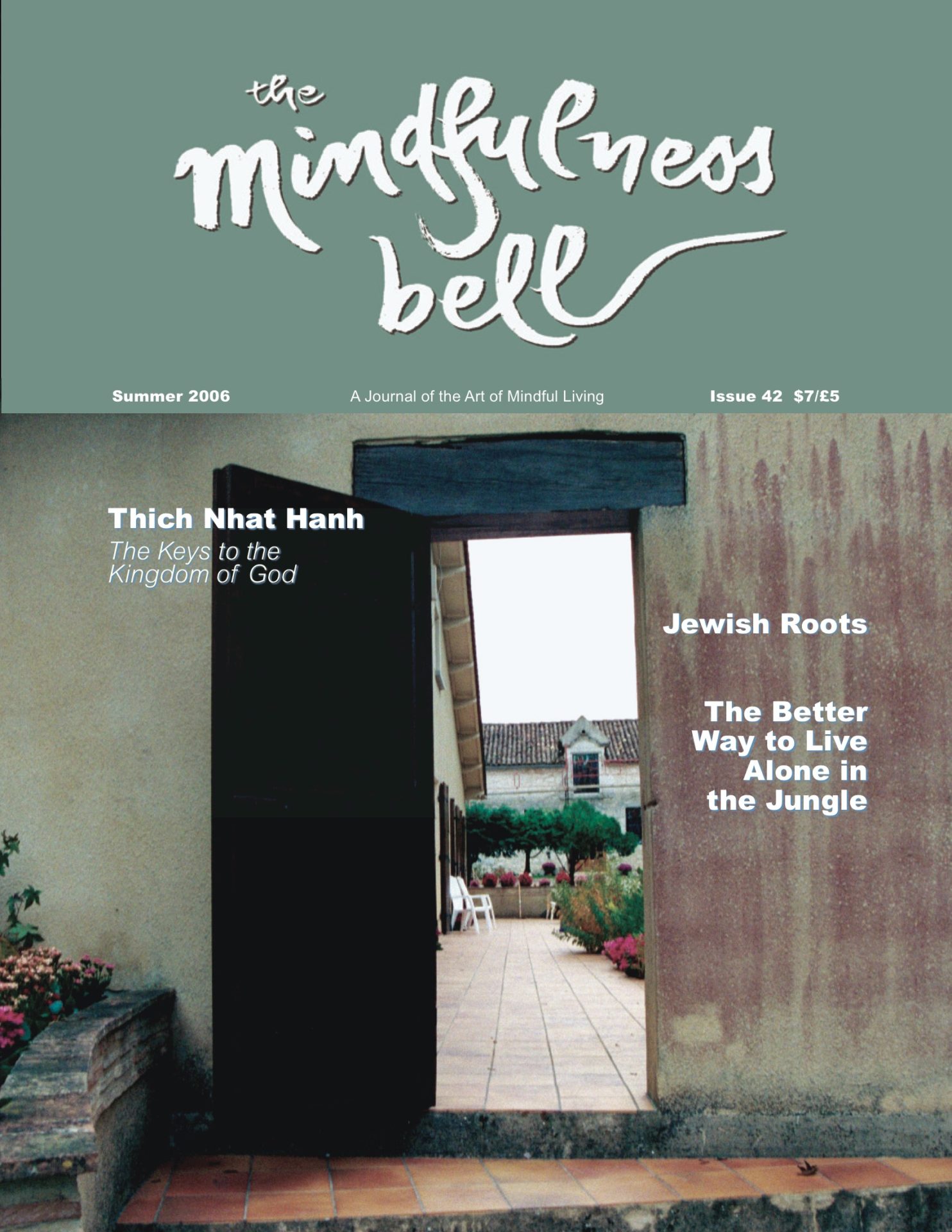By Sister Annabel, True Virtue
In response to a request from her teacher, Thich Nhat Hanh, Sister Annabel is writing about her life. Thay suggested that her story be serialized in the Mindfulness Bell and then put together in a book. In this first installment, when the story begins she is in her early thirties.

In 1984 I was in Cheshire, England, working in an organic garden.
By Sister Annabel, True Virtue
In response to a request from her teacher, Thich Nhat Hanh, Sister Annabel is writing about her life. Thay suggested that her story be serialized in the Mindfulness Bell and then put together in a book. In this first installment, when the story begins she is in her early thirties.

In 1984 I was in Cheshire, England, working in an organic garden. In the winter it was sometimes very cold. As the wet English snow fell and the bitter easterly wind blew, we picked spinach. What can be more painful than the blood trying to make its way through frozen fingertips? In the greenhouse the broccoli and Chinese cabbage flourished even in winter and if the mice did not come in and eat the seedlings, lettuce would grow too. It was wonderful how fine the vegetables looked without herbicides and artificial nitrates. I was happy to learn that cultivating organically is possible and I felt the vegetables were happy too.
The garden, however, did not completely fulfill me. Somewhere something very important was missing. I had not found my sangha. Because of this, Buddha and dharma or the spiritual life were lacking. I had not arrived, I was not at home. Still I was able to dream and one night I had a dream to show me there was a way ahead. In the dream I was walking up a green hill and I came to the top of the hill. There was a wall or fence along the top of the hill, stopping me from going down the other side. I walked up and down the fence, searching for a way to climb over. With difficulty, I did climb over. There was a farmer on the other side; it may have been my father. He showed me a gate in the fence and asked me why I had not used it. It would have been so much easier. These years of wandering without arriving had been like struggling over a fence and only now had I seen the gate. The gate had always been there, only I was not aware, I had not seen it. It
is not necessary to struggle, but because we cannot see, because we are ignorant, we struggle.
Now that I have arrived, is that not the happiest thing? “I have arrived” does not necessarily mean that I have realized the path. It just means that I know I am on the path and I do not need to be anywhere else.
The dream was a presage because the next day I received the newsletter of the Buddhist Peace Fellowship U.K. and in the newsletter was the poem “Please Call Me By My True Names” with a photograph of the Vietnamese Zen Monk Thich Nhat Hanh. Thay was smiling and holding a teapot. Photographs of Thay were rare at that time and this teapot photograph appeared in many places. It was perhaps the only one available. I already had an idea of what Buddhist monks looked like because I had spent time in India, but Thay did not conform to that idea. Intellectually I did not understand the poem but the images were music to my soul: the caterpillar—whoever would look so deeply at caterpillars? Whoever would have the time to look deeply at caterpillars?
Finding Safe Anchorage
In that poem and that photograph I was beginning to arrive. I did not have the fruit of arrival but the fruit of going in the direction of arrival. There was a safe anchorage for my boat that had been sailing for so many years without a port of call. In 1980, I had gone to India to practice Buddhism with Tibetan nuns. Before that I had lived in a community along with practitioners of different faiths. I had even camped out around Greenham Common in order to resist any attempt to move nuclear missiles from that base. But in my heart I was not at home and I had not found the path I most wanted to tread.
As I became more involved with the Buddhist Peace Fellowship, I learned about the Vietnamese refugees detained in refugee camps in Hong Kong. Hong Kong was a British protectorate at that time. So I met people who had been in those camps and I heard their stories. I learned that there was a place called Plum Village that opened its doors to guest practitioners for one month every year from July 15th until August 15th. A friend and I thought of going in the summer of 1985, but when I wrote I received a reply from Sister True Emptiness (Sister Chan Khong) saying all places were taken. It was not yet time for me to go.
I was still not sure if Plum Village was my true spiritual home. Indeed when I first read part of The Miracle of Mindfulness, I was not sure if it was for me. After the intricacies of Tibetan Buddhism, its complex rituals, its teachings couched in descriptions of strange and distant scenes, something so homely and simple was a shock that was difficult to accept. When I could fully accept Plum Village teachings, Plum Village would accept me. To do that I had to meet Thay and Sister True Emptiness.
Fortunately Thay agreed to come to England in March 1986. It was still bitterly cold and I organized a retreat in Cumbria in a drafty old castle that some Tibetan monks had acquired and rented out for others to have their retreats. This castle had huge rooms that could never be heated. The fireplaces gave out heat to a space only one meter in front of them. One day it snowed and one day it was fine enough for us to walk to the sea. Thay did not complain. He ate the English food that the retreatants ate. He attended all activities on the schedule and led them all as well as giving the dharma talk. Gently he encouraged me to practice by saying “and you do not need to hurry, just take one step at a time,” because I wanted to run everywhere, doing everything. Before the retreat began, Thay invited me into his room to ask me what I thought of the daily schedule he proposed for the retreat. I was moved: why would Thay ask me? After all I was a complete beginner, I knew nothing. Still, I said the proposed schedule was very good.
Thay had someone bring a cloud bell from Plum Village to use to announce activities and summon us to mindfulness. A cloud bell is a flat piece of bronze molded in the shape of a cloud. It has a sharper sound than the round bowl-shaped bell. It was invited in the draughty corridor on the ground floor of that castle twenty years ago. Thay must have felt cold. When I looked at Thay’s bed it looked as if it had never been slept in. I imagined Thay sat in meditation all night long. Sister True Emptiness asked me to try to find an electric heater for Thay’s room. I do not remember that we paid Thay or Sister True Emptiness any honorarium.
The Door Opens
When we went to London Thay gave a talk in Friend House on Euston Road, the main center for Quakers in the United Kingdom. Again I was moved when Thay asked me to tell the audience about
the Buddhist Peace Fellowship, as if I had something worth saying. Thay treated others with that kind of respect. Everyone had something to offer and Thay gave them a chance to offer it.
How lucky I felt as I went to sleep! How lucky to have met Thay, although I was on my own again. I joined a Tibetan Sangha in London for a time and I was happy that having practiced with Thay I now knew how to prostrate. Before I met Thay I did not like to prostrate. It was just an outer form. Thay taught me the content of prostration—surrendering all idea of a separate self and touching the quality of great understanding, great action, and great compassion—not as mine and also not apart from me; real but neither inside or outside. My practice in that Tibetan-based Sangha was successful because of what I had learned in the fiveday retreat from Thay.
Before, Thay’s teachings had seemed too simple for me; now they were miraculously simple, real, and concrete. During that retreat I wore brown clothes, not intentionally; it was just that the warm clothes I had with me were brown. And sitting in front of Thay, who was wearing a brown robe, I felt we were one. The simple act of holding up a sheet of paper, as Thay did in the dharma talk on the last day of the retreat, touched me deeply. The talk was on the Heart Sutra. That sutra had been a closed door for me; the commentaries I had seen and heard on it had been complex and difficult to understand. Now it sufficed to look at a piece of paper and see the cloud floating in it. The piece of paper was truly empty of a separate self—that, the intellect could understand—but Thay transmitted something else. Thay’s own emptiness and my emptiness were in it.
How lucky to meet my enlightened teacher in my own country! The Tibetans had told me that that was where I would meet my teacher and he would not be Tibetan, but from Far East Asia. The prophecy came true. Prophecy comes not just from the mind of the one who prophesies but from the mind of the one who is prophesied to.
“Here Is India”
In Plum Village Thay sat on a hammock in a gray robe. He was preparing the Upper Hamlet for the summer opening. Thay’s first words to me were “Here is India, India is here.” I thought Thay meant it was very hot, as hot as in India. It was deeper than that. To me India was home, at least my spiritual home. I believed spiritual home could not be found anywhere else. I missed India with a kind of longing. “Here is India” meant you have arrived, you are home. My conscious mind did not realize it, but deep down, the seed was sown. One month later, in the Lower Hamlet, I realized I was home. It was a feeling of being at home that I had not felt since I was a child. Looking up at the hills of the Dordogne to the north of the Lower Hamlet, I was home. Contemplating the white knobbed stones that made the walls of the Red Candle Meditation Hall, I was home. These things had always been part of me and I had always been part of them.
At first Thay allowed me to dream of my Indian home, perhaps it was part of Thay’s dream too. Thay said: “Although you cannot be in India you can dream of being there. For instance there is the little hut you make of bamboo with its banana leaf roof and there is the little garden you plant with mustard greens. So simple is the ideal life.” Then later Thay would ask: “Have you ever felt that India is in London?” To which I answered a definite “No.” Somehow I know that India is not a place on the map. India is a place in my mind.

The Upper Hamlet has its own enlightened ambience. This ambience comes from the practice of mindfulness, concentration, and insight. The ambience tells you that you are walking on holy ground. The old stone house had its musty odor as you came in on the ground floor. It had been built to be cool in the heat of the summer sun and not lose too much heat in the winter cold, so the stone walls were thick and the windows few and small. The half-cylindrical tiles of the roof were not cemented into place but cupped into each other so that they could slip and leave gaps that allowed the rain in. The people of the neighborhood climbed onto their roofs at least once a year and replaced the tiles that had slipped out of place. In the past not many tiles needed to be replaced but since the invention of the supersonic airplane this has changed. The airplane breaks the sound barrier just over Plum Village and the resulting boom shifts the tiles. Nowadays people prefer to cement their tiles into place.
When I first arrived in Plum Village that airplane had recently been invented. None of us knew about repairing roofs and we were subjected to numerous leaks. The attics were full of buckets and tubs to collect rain before it penetrated beneath, but we never covered all the leaks and if the rain was heavy enough it was sure to come into your bedroom. One night I moved my bed to the other side of the room but the leak followed me. Not only rain came in but snow too. In the first two years I was in Plum Village it snowed significantly and the snow stayed for many days. There was enough room between the tiles for powdery snow to blow into the attic. This could reach six inches and it was important to clear it because the weight could break the ceiling. Clearing snow in the attic was very cold work. We filled rubbish bins with snow and they were very heavy to move. There was no heat up there and the bitter wind blew in through the tiles. Soon my hands and feet were frozen stiff.
Each bedroom had a small ceramic and iron wood stove. We would buy these second-hand from local people who wanted to get rid of them. There was a hole in the wall for an aluminum pipe to take the smoke outside. The stove did not hold much wood so after an hour or so if you did not replenish it, it would go out. We found the wood on the Plum Village land. Lower Hamlet consisted of twenty-one hectares. I helped the four young Vietnamese refugees who lived in Plum Village at that time by splitting logs and sawing branches to put in the stoves. These young men went out and cut down trees for us. Our neighbor, M. Mounet Père, was a bodhisattva. One day he came into the kitchen and said that in France you cannot cut down trees on other people’s property. It seems that our young Vietnamese refugees did not know where our property ended. To put right this ignorance he took us to the Mairie (city hall) and showed us the plan of the different parcels of land that had been purchased for the Lower Hamlet. He then took us on a tour of the boundaries, showing us exactly where Lower Hamlet territory began and ended. M. Mounet Père was a good man. He promised Thay he would not go hunting when the annual summer retreat was held in Plum Village. He taught us many things about gardening and cultivation of the land. He baked tartes aux pommes (apple pies) and sold them and when his oven—which he had made himself—was hot he allowed us to bake our bread in it.
M. Mounet would visit us almost every day to find out how we were doing and to offer us any advice or help we might need. I was truly grateful for his presence in those early days. His home is now a part of Lower Hamlet. He died unexpectedly and we sent spiritual energy for him. Sister True Emptiness went to his house to send energy over the body. She had not witnessed undertakers working with a corpse before, since in Vietnam it is always the family that washes and clothes the body of a loved one. She was shocked by what she saw as a heartless way of treating the body. We went to the burial in the local cemetery where every year on All Souls’ Day we place flowers on his grave. Sister True Emptiness has always encouraged her younger monastic sisters to perform a ceremony of sending energy on that day to those who have passed away in the neighborhood and we do this in Vermont also. I was always moved when I saw how Thay and Sister True Emptiness included whoever they met, whether Buddhist or not, within the embrace of their spiritual concern.
Sister Annabel Laity, Chan Duc, True Virtue, was born in England, and studied Classics and Sanskrit before going to India to study and practice with Tibetan nuns. She has been a disciple of Thich Nhat Hanh since 1986, became a Dharma Teacher in 1990, and was Director of Practice at Plum Village for many years. Since 1997, she has been director of the Maple Forest Monastery, Vermont, and was installed as abbess at the Green Mountain Dharma Center in 1998. In 2000, she was the first Western nun to teach the Dharma in China.

